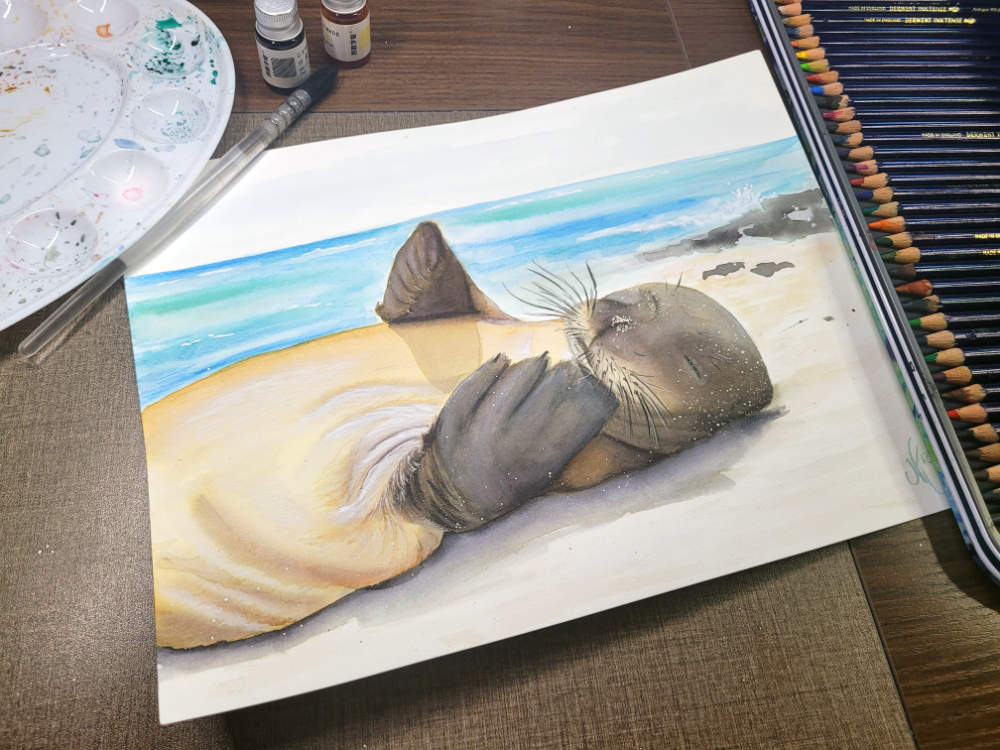
Hawaiian Monk Seals
The Hawaiian Monk Seal (Neomonachus Schauninsladi) is one of the most endangered species in the world. With its cute appearance and being one of only two mammals native to the Hawaiian islands, this creature has captured the hearts of many. What makes these animals so likable yet so endangered?
Scientific Name: Neomonachus Schaunislandi
Phylum: Chordata
Order: Carnivora
Genus: Neomonachus
Kingdom: Animalia
Class: Mammalia
Family: Phocidae
Species: N. Schaunislandi
IUCN Redlist Status:

Blubbery Cuteness!

When born, Hawaiian Monk Seals are black. When they mature, their coats become dark gray to brown on their backs, and their bellies are light gray to yellowish brown. They molt once a year. Hawaiian Monk Seals can grow algae on their coats. Most seals have scars or bleach spots on them. These markings help scientists and researchers identify them. Males and females are similar in size.
Where Do They hang out?

Hawaiian Monk Seals are exclusive to Hawaii. They mainly reside in the northwestern islands, with a small number living on the main islands. The Hawaiian Monk Seals love warm water and spend two-thirds of their time there. They are seen on the beaches of Hawaii.
Food Time!

Hawaiian Seal Monks are pursuit predators, meaning they chase after their prey. They mainly eat octopuses, common fishes, eels, squids, and crustaceans. They like to forage near the seafloor and go after food that hides.
Curious by nature

Hawaiian Monk Seals are friendly and won’t attack humans unless provoked. Young seals may seek contact with humans, and adult seals may become aggressive if they interact with humans at a young age. Wild monk seals never seek contact with humans, and they get relocated when they start seeking humans or interact with them often.
Monk Seal Families

Hawaiian Monk Seals mate at sea. Females can become pregnant as early as 5 years old. They carry the pup for 10 months before giving birth on land. A newborn pup nurses for a month while the mother does not go out and forage for food. After the nursing period, the pup learns how to swim and forage. There are more males than females. They live up to 30 years.
5 Fun Facts About Hawaiian Monk Seals
Here are 5 fun facts about Hawaiian Monk Seals that you can add to your bag of information:
They can hold their breath for up to 20 minutes
The Hawaiian name is ilio-holo-i-ka-uaua, which means dog that runs in rough water.
It is the official state animal of Hawaii
Their name comes from the folds on the neck, which look like monks’ robes.
They came to Hawaii 3.5 million years ago.
Threats to their survival
Hawaiian Monk Seals are threatened by food limitation, shark predation, entanglement, male seal aggression, habitat loss, fishery interactions, disease, contaminants, human-seal interactions, and intentional killing. They often get tangled up in discarded fishing lines. Dogs and cats can give them parasites. Global warming leads to habitat loss. There are around 1,570 left in the wild, and the IUCN considers them endangered.
Efforts to save the Hawaiian monk seal
The National Oceanic Atmosphere Administration (NOAA), has taken steps to help increase its population. They have done translocation, captive care, habitat cleanup, and working with native Hawaiians to educate people about them.
How you can Help
While policy changes are critical, public support is equally important. Here’s how you can contribute to pangolin conservation:
- Give the seals space when you see them
- Reduce your carbon footprint to help fight climate change,
- Help combat ocean trash by not using single-use plastics
- Shop at Artsefact: Part of the proceeds go towards wildlife and habitat conservation.
A Future for the Hawaiian Monk Seal
The Hawaiian Monk Seal’s story is far from over, but the recent conservation efforts by the National Oceanic Atmosphere Administration (NOAA) offer a hopeful chapter. This species can begin to recover with continued collaboration between governments, NGOs, and the public. Every action—no matter how small—brings us closer to a world where Hawaiian Monk Seals thrive in the wild once more.
Let’s celebrate this progress and continue working toward a brighter future for one of the planet’s most extraordinary creatures.
Hawaiian Monk Seal Fact Sheet!
Would you love to have all the info compact on a factsheet? Sign up for our e-mail Newsletter to unlock it!

Resources
- National Oceanic Atmosphere Administration (NOAA) – Hawaiian Monk Seal
- Wikipedia – Hawaiian Monk Seal
- State of Hawai’i Division of Aquatic Resources – Hawaiian Monk Seal – Īlio-holo-i-ka-uaua – “Dog that runs in rough water”
- National Wildlife Federation (NWF) – Hawaiian Monk Seal
- The Marine Mammal Center – Hawaiian Monk Seal Conservation
- Ocean Conservancy – Hawaiian Monk Seal


